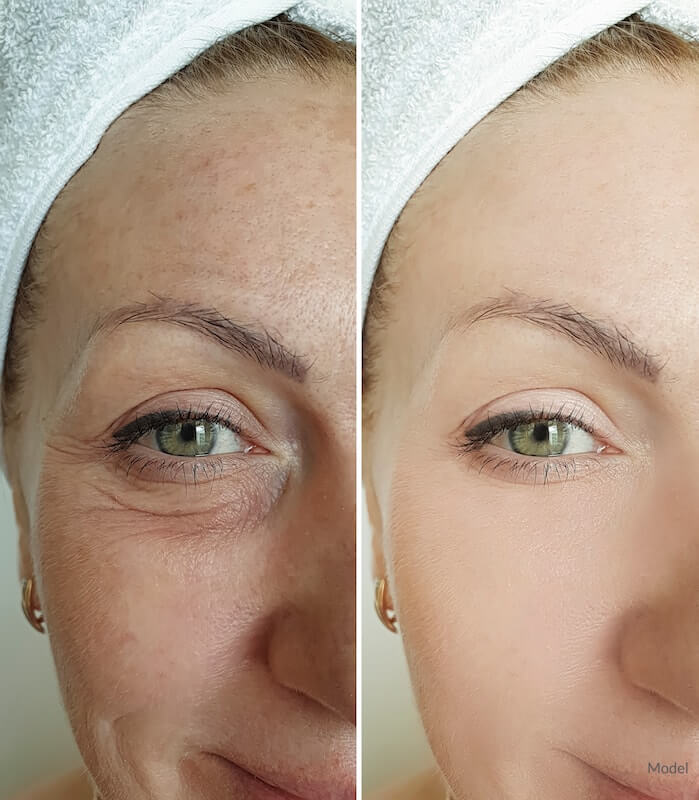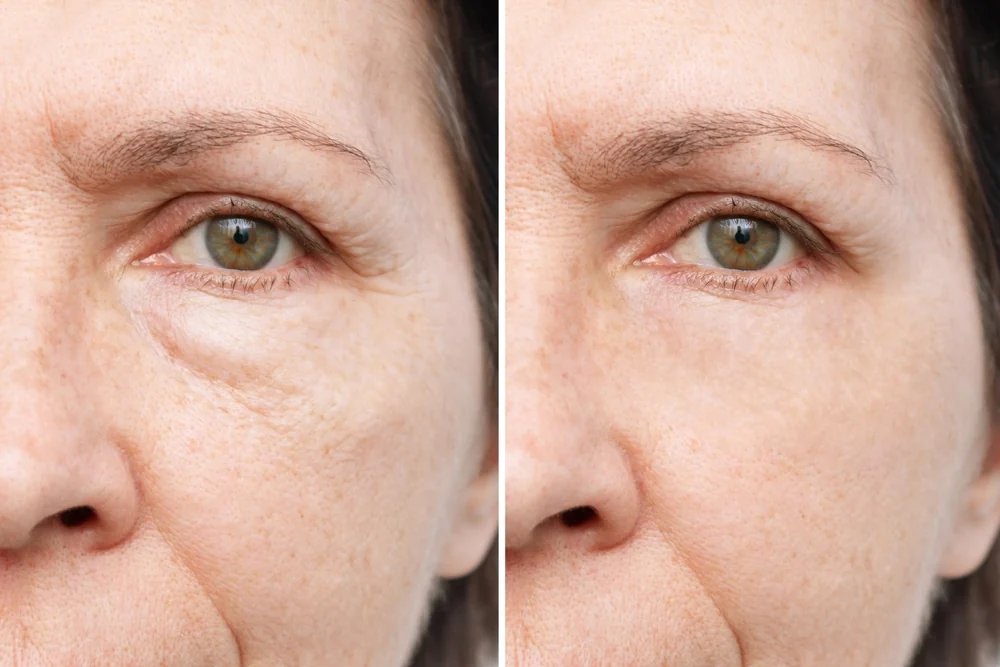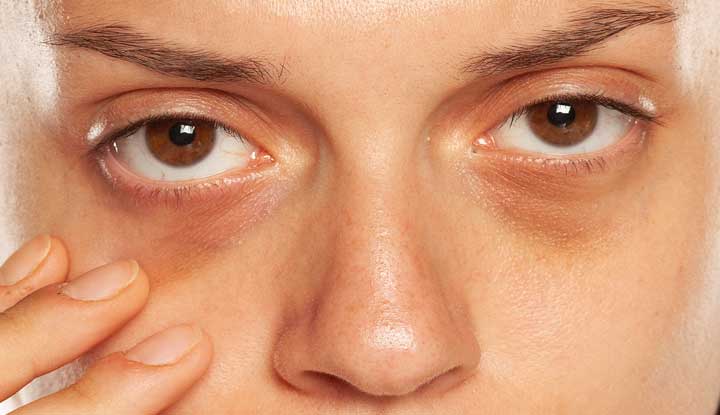Have you ever wondered if those pesky bags under your eyes will ever disappear? Well, look no further, because we have the answers you’ve been searching for. In this article, we’ll explore the causes of baggy eyes and provide helpful tips on how to get rid of them. From lifestyle changes to effective products, we’ve got you covered. So say goodbye to tired-looking eyes and hello to a refreshed and rejuvenated appearance. Let’s dive right in!

This image is property of static.wixstatic.com.
Causes of Bags Under Eyes
Aging
As you age, the skin around your eyes naturally becomes thinner and loses its elasticity. This can cause the fat that supports your eyes to shift downward, leading to the formation of bags under your eyes. Additionally, the muscles that normally keep the fat in place weaken over time, contributing to the sagging and puffiness.
Genetics
Your genes can also play a role in the development of bags under your eyes. If your parents or other family members have this cosmetic concern, it is likely that you may experience it too. Genetic factors can influence the structure and composition of your skin and the way your body retains fluids, making you more susceptible to bags under your eyes.
Fluid Retention
Excess fluid retention can lead to the appearance of bags under your eyes. Factors such as salt intake, dehydration, hormonal changes, and seasonal allergies can cause your body to retain fluid, which can accumulate under your eyes and create puffiness.
Allergies
If you suffer from allergies, you may notice that your eyes become puffy and irritated, giving the impression of bags. Allergic reactions can cause the blood vessels around your eyes to dilate, resulting in swelling and puffiness. Common allergens like pollen, pet dander, dust mites, and certain foods can trigger these reactions.
Sleep Deprivation
Lack of sleep can have a noticeable impact on the appearance of your eyes. When you don’t get enough rest, your blood vessels dilate, causing the skin under your eyes to appear darker and your eyes to look puffy. Sleep deprivation can also lead to fluid retention and inflammation, worsening the appearance of bags under your eyes.
Treatment Options
Home Remedies
There are several simple and natural remedies you can try at home to reduce the appearance of bags under your eyes. Cool compresses made with cold water, chilled tea bags, cucumber slices, or potato slices can help to constrict blood vessels and reduce puffiness. Applying chilled spoons to your eyes can also provide temporary relief by soothing and tightening the under-eye area.
Over-the-Counter Solutions
If home remedies are not giving you the desired results, you can consider using over-the-counter solutions specifically formulated to reduce bags under the eyes. Eye creams containing ingredients like caffeine, vitamin E, and hyaluronic acid can help to tighten and firm the skin. Rollerball or gel products that provide a cooling sensation can also help to reduce swelling and improve circulation. Additionally, topical serums that contain antioxidants and anti-inflammatory ingredients can provide relief.
Prescription Medications
In some cases, your healthcare provider may prescribe medications to address the underlying causes of bags under your eyes. Retinoids, which are derived from vitamin A, can help to improve skin texture and reduce the appearance of bags. Corticosteroids may be prescribed to reduce inflammation and swelling, particularly if allergies are the main cause of your under-eye bags. Antihistamines can also be used to manage allergic reactions and minimize puffiness.
Cosmetic Procedures
If home remedies and over-the-counter solutions do not provide satisfactory results, you may consider cosmetic procedures to address bags under your eyes. Chemical peels can help to rejuvenate the skin and improve its texture and appearance. Fillers, such as hyaluronic acid or collagen, can be injected to restore volume and smooth out the under-eye area. In more severe cases, blepharoplasty, a surgical procedure involving the removal of excess skin and fat, may be recommended.
Lifestyle Changes
Getting Sufficient Sleep
One of the most effective ways to reduce bags under your eyes is to prioritize getting enough sleep. Aim for seven to eight hours of quality sleep each night. Establish a regular sleep routine, create a comfortable sleep environment, and limit exposure to electronic devices before bed to promote better sleep. By giving your body the rest it needs, you can minimize fluid retention and inflammation that contribute to puffy eyes.
Healthy Diet and Hydration
Maintaining a healthy diet and staying hydrated can have a positive impact on the appearance of your eyes. Focus on consuming a balanced diet rich in fruits, vegetables, whole grains, and lean proteins. Avoid excessive salt intake, as it can cause your body to retain fluid and worsen under-eye bags. Drinking an adequate amount of water daily can help to keep your skin hydrated and prevent puffiness.
Reducing Salt Intake
High sodium intake can lead to fluid retention and increase the prominence of bags under your eyes. Limiting your consumption of processed and salty foods can help to reduce fluid retention in the body. Instead, opt for fresh and whole foods that are low in sodium. Flavor your meals with herbs, spices, and lemon juice rather than relying on salt for taste.
Managing Allergies
If allergies are contributing to your under-eye bags, taking steps to manage and minimize exposure to allergens can provide relief. Avoid known allergens, such as pollen, pet dander, and dust mites, as much as possible. Keep your living environment clean and free of allergens by regularly dusting, vacuuming, and using air purifiers. Over-the-counter antihistamines or prescribed medications can also help to alleviate allergy symptoms and reduce puffiness.
Quitting Smoking
Smoking not only harms your overall health, but it can also worsen the appearance of bags under your eyes. Smoking causes blood vessels to constrict, reducing blood flow and oxygen supply to the skin. This can lead to the breakdown of collagen and elastin, making the skin around your eyes more prone to sagging and puffiness. Quitting smoking can help to improve your overall skin health and minimize under-eye bags.
Home Remedies
Cool Compresses
Cool compresses are a simple and effective way to reduce puffiness and soothe tired eyes. Dip a clean cloth or cotton pads in cold water and place them over your closed eyelids for about 10 to 15 minutes. The cool temperature helps to constrict blood vessels and reduce swelling, providing temporary relief from under-eye bags.
Tea Bags
Tea bags, particularly those containing caffeine, can help to tighten the skin and reduce under-eye bags. Steep two tea bags in hot water for a few minutes, then remove them and let them cool. Place the cooled tea bags over your closed eyes for around 15 minutes. The caffeine in the tea constricts blood vessels and reduces inflammation, resulting in diminished puffiness.
Cucumber Slices
Cucumber slices have long been used as a natural remedy for under-eye bags. The cool temperature of cucumbers provides a soothing effect, while their high water content hydrates the skin. Cut thick slices of cucumber and place them over your closed eyes for about 10 to 15 minutes. This can help to reduce swelling and refresh the appearance of your eyes.
Potato Slices
Potato slices can also help to alleviate under-eye bags due to their natural astringent properties. Slice a raw potato into thick pieces and place them in the refrigerator for a few minutes to chill. Then, place the chilled potato slices over your closed eyes for about 10 to 15 minutes. The potatoes can help to tighten the skin and reduce puffiness, giving your eyes a rejuvenated look.
Chilled Spoons
Chilled spoons are a quick and easy remedy for under-eye bags. Place metal spoons in the refrigerator for a few minutes until they become cold. Then, hold the rounded portion of the chilled spoons against your closed eyes for a few seconds at a time. The cold temperature constricts blood vessels and reduces inflammation, providing temporary relief from under-eye bags.

This image is property of bridgestobeauty.com.
Over-the-Counter Solutions
Eye Creams
Eye creams specifically formulated to address puffiness and reduce bags under the eyes can be an effective over-the-counter solution. Look for eye creams that contain ingredients such as caffeine, vitamin E, hyaluronic acid, or retinol. These ingredients can help to tighten the skin, improve hydration, and stimulate collagen production, reducing the appearance of bags and promoting a smoother under-eye area.
Rollerball or Gel Products
Rollerball or gel products provide a cooling and massaging effect, making them suitable for reducing under-eye puffiness. These products often contain ingredients that help to improve blood circulation, reduce swelling, and tighten the skin. Gently apply the rollerball or gel around your eyes, following the product instructions. The massaging motion can help to drain excess fluid and soothe the under-eye area.
Topical Serums
Topical serums formulated with antioxidants and anti-inflammatory ingredients can help to target under-eye bags. These serums are typically lightweight and easily absorbed, delivering active ingredients directly to the skin. Look for serums that contain ingredients like vitamin C, green tea extract, chamomile, or aloe vera. These ingredients can help to reduce puffiness, brighten the skin, and improve the overall appearance of your under-eye area.
Eye Masks
Eye masks, often made of gel or fabric, are designed to be applied over the eyes for a specified period of time. They are infused with ingredients that help to reduce puffiness, hydrate the skin, and improve circulation. Eye masks provide a soothing and cooling sensation, making them a popular option for reducing under-eye bags. Follow the instructions provided with the eye mask for optimal results.
Prescription Medications
Retinoids
Retinoids are a class of prescription medications derived from vitamin A. They are commonly used to treat various skin conditions and can also be beneficial for reducing the appearance of bags under the eyes. Retinoids work by stimulating collagen production, improving skin texture, and reducing the visibility of fine lines. Your healthcare provider can determine the appropriate retinoid and dosage for your specific needs.
Corticosteroids
Corticosteroids are often prescribed to address inflammation and swelling, particularly if allergies are the primary cause of your under-eye bags. These medications work by reducing the immune response and blocking allergic reactions. Corticosteroids can be prescribed as topical creams or ointments, or taken orally, depending on the severity of your condition. It is important to follow your healthcare provider’s instructions and use corticosteroids as directed.
Antihistamines
Antihistamines are commonly used to manage allergic reactions and can provide relief from under-eye bags caused by allergies. These medications work by blocking the effects of histamine, a chemical released during an allergic response. By reducing histamine levels, antihistamines help to alleviate symptoms such as itching, redness, and puffiness. Both over-the-counter and prescription antihistamines are available, depending on the severity of your allergies.

This image is property of plasticsurgeonsnyc.com.
Cosmetic Procedures
Chemical Peels
Chemical peels are cosmetic procedures that involve the application of a chemical solution to the skin to remove the outermost layer. This promotes the growth of new, healthier skin and can improve the appearance of bags under the eyes. Chemical peels can help to reduce fine lines, wrinkles, and pigmentation irregularities, making the skin appear smoother and firmer.
Fillers
Injectable fillers, such as hyaluronic acid or collagen, can be used to add volume and smooth out the under-eye area. These fillers are carefully injected into the skin to reduce the depth of under-eye hollows and minimize the appearance of bags. The procedure is minimally invasive and can provide immediate results, with effects lasting several months to a year, depending on the type of filler used.
Blepharoplasty
Blepharoplasty, also known as eyelid surgery, is a surgical procedure aimed at removing excess skin and fat from the eyelids. This is a more invasive option for addressing bags under the eyes, typically reserved for more severe cases. Blepharoplasty can help to tighten the skin, reposition fat, and improve the overall contour of the eyelids. The procedure is performed by a skilled plastic surgeon and requires a period of recovery.
How Long Do Bags Under Eyes Usually Last?
Temporary Nature
In many cases, bags under the eyes are temporary and may improve with lifestyle changes, home remedies, or over-the-counter solutions. Depending on the underlying cause and the effectiveness of the chosen treatment options, you may notice a reduction in the appearance of bags within a few days to a few weeks.
Chronic Bags Under Eyes
In some instances, bags under the eyes may persist despite efforts to reduce them. Chronic bags can be caused by factors such as genetics, structural changes in the skin, or underlying medical conditions. If you are dealing with chronic bags under your eyes, it may be necessary to seek professional advice and explore more advanced treatment options, such as prescription medications or cosmetic procedures.
This image is property of my.clevelandclinic.org.
Preventing Bags Under Eyes
Sun Protection
Protecting your skin from the damaging effects of the sun can help to prevent the formation of bags under your eyes. Apply a broad-spectrum sunscreen with a high SPF to the delicate skin around your eyes, even on cloudy days. Wear sunglasses that provide UV protection to shield your eyes and surrounding skin from harmful sun rays.
Regular Eye Care
Taking care of your eyes and the surrounding skin can help to prevent or minimize the development of bags. Be gentle when removing makeup, avoiding excessive rubbing or tugging. Use a mild cleanser specifically formulated for the eye area and a soft cloth or cotton pads to cleanse the skin. Keep the under-eye area moisturized with an eye cream to maintain hydration and elasticity.
Avoid Rubbing or Pulling
Rubbing or pulling at the skin around your eyes can worsen the appearance of bags. The skin in this area is delicate and prone to damage, so it is important to handle it with care. Avoid unnecessary rubbing or scratching, and be mindful of any habits that involve touching or pulling at your eyes. Instead, use gentle tapping motions when applying products or performing home remedies.
When to Seek Medical Advice
Persistent or Severe Bags Under Eyes
If home remedies and over-the-counter solutions do not effectively reduce the appearance of bags under your eyes, it may be time to seek medical advice. Persistent or severe bags could be a sign of an underlying issue that requires medical intervention. A healthcare provider or dermatologist can assess your condition, identify the cause, and recommend appropriate treatment options.
Underlying Medical Conditions
Bags under the eyes can sometimes be associated with underlying medical conditions such as thyroid disorders, kidney problems, or sinus issues. If you suspect that there may be an underlying health issue contributing to your under-eye bags, it is important to consult a healthcare professional for a thorough evaluation and appropriate medical management.
Unexplained Swelling
If you experience sudden and unexplained swelling in addition to bags under your eyes, it is advisable to seek medical advice. This could be an indication of an allergic reaction or another medical condition that requires prompt attention. A healthcare provider can help determine the cause of the swelling and recommend the necessary treatment.
In conclusion, bags under the eyes can be caused by factors such as aging, genetics, fluid retention, allergies, and sleep deprivation. Treatment options range from home remedies and over-the-counter solutions to prescription medications and cosmetic procedures. Adopting lifestyle changes like getting sufficient sleep, maintaining a healthy diet, reducing salt intake, managing allergies, and quitting smoking can also help in preventing and reducing bags under the eyes.




